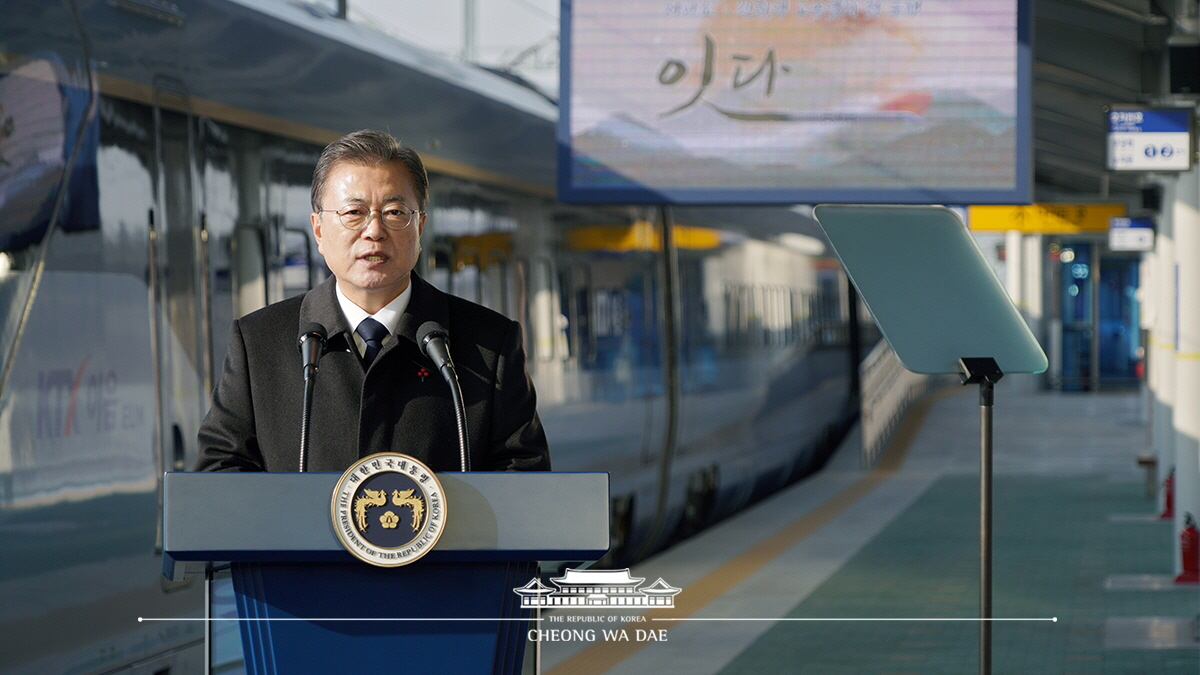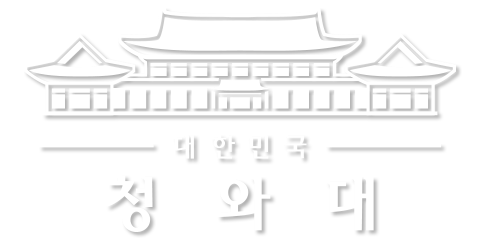이 웹사이트는 제19대 대통령 임기 종료에 따라 대통령기록관이 「대통령기록물 관리에 관한 법률」에 의해 이관받아 서비스하는 대통령기록물입니다. 자료의 열람만 가능하며 수정 · 추가 · 삭제는 불가능합니다.
다만, 「개인정보보호법」에 의하여 개인의 정보를 보호받기 원하시는 분은 관련 내용(요청자, 요청내용, 연락처, 글위치)을 대통령 웹기록물 담당자(044-211-2253)에게 요청해 주시면 신속히 검토하여 조치해 드리겠습니다. 감사합니다.
SPEECHES & REMARKS
BRIEFINGS
Remarks by President Moon Jae-in at Ceremony to Inaugurate Low-Carbon, Eco-Friendly High-Speed Train

Fellow Koreans,
I am visiting a train station for my first official tour in the New Year of the White Ox. Wonju Station is still largely empty as COVID-19 has deprived us of once routine activities. This year, for sure, we will restore our daily lives and encounter a new Republic of Korea.
A low-carbon, eco-friendly high-speed train will be put into service starting tomorrow. This is a vigorous beginning of the Republic of Korea’s march toward becoming a leading nation. The public named the train the “KTX-Eum” from the Korean word for “connection” to convey a sense of uniting regions and people for continued happiness. To live up to people’s expectations, we will initiate a great transformation in our daily lives this year through the strength of mutual benefit that brings regions and people together.
The KTX-Eum is a high-speed electric multiple unit train. Since it needs no separate locomotive, it can carry more passengers. It can also accelerate and decelerate over a short distance. Consequently, this train is well suited for lines with many stations separated by short distances. In 2004, Korea became the fifth country in the world to introduce a high-speed train. Since 2007, we have been building high-speed trains and railroads with our own technology. With the KTX-Eum going into operation, the Republic of Korea can now be seen as a bona fide high-speed train powerhouse.
Trains are one of the leading means of green transportation, and the KTX-Eum is the best among them. Powered by electricity, it emits no fine dust while carbon dioxide emissions are only 70 percent of those from diesel-powered trains and 15 percent from passenger vehicles. All carriages are linked with the Korea-made fourth-generation rail wireless communication network – the first of its kind in the world. The rapid exchange of data between trains and control centers has significantly enhanced their safety. All passengers can use Wi-Fi and mobile communications with less constraint. The train’s interior and exterior design and its roomy seating arrangement are very impressive as well.
It is all the more welcoming that the era of high-speed rail service has been brought to the country’s central inland region. As Korea’s second oldest and longest trans-peninsula railroad, the Jungang Line connects Cheongnyangni, the point of origin, to Gyeongju and runs all the way to Busan via the Donghae Line. Nonetheless, this route is still served most often by diesel-powered Mugunghwa-ho trains. There are even night trains that take seven hours to reach Busan’s Bujeon Station, the last stop of the Donghae Line, from Seoul’s Cheongnyangni Station.
Thanks to the KTX-Eum, however, it now takes about an hour from Cheongnyangni Station to Jecheon, Chungcheongbuk-do Province, and two hours to Andong, Gyeongsangbuk-do Province. Once construction of the unfinished portion of the electrified double-track line is completed in 2022, it will take only three hours to reach Busan. A more advanced, superior high-speed train service has now become available to the residents of Gangwon-do and those in the inner regions of Chungcheongbuk-do and Gyeongsangbuk-do who’ve been waiting a long time for the launch of a high-speed rail system. It will bring about an effect akin to killing three birds with one stone – stimulating local economies, reducing environmental pollution and promoting mutual benefit between metropolitan Seoul and local areas.
Numerous people have put in a lot of hard work. Researchers and engineers from Hyundai Rotem and SMEs joined forces to build the KTX-Eum with our country’s core technology. Approximately 180,000 field workers have been working very hard for nine years to lay the electrified double-track line.
I would also like to express my profound gratitude to Gangwon Province Governor Choi Moon-soon, Chungcheongbuk-do Governor Lee Si-jong and the executives and employees of the Korea National Railway and Korea Railroad Corporation for their hard work to date. I sincerely congratulate you on the inaugural run of the KTX-Eum – the train of the people, created by them and running for them.
Fellow Koreans,
If roads were the arteries of our economic development in the 20th century, railroads constitute the main arteries of economic and social advancement in the 21st century. The force, which spearheads the grand transformation of our daily lives and supports implementation of the Green, Digital and Regionally Balanced New Deals, emanates from the railroad as well. The Government will push ahead with three policies to innovate rail transport.
First of all, we will make this year – when we are obliged to begin implementing the Paris Agreement – the first year for the supply of low-carbon, eco-friendly trains. By 2029, we will replace all of the diesel passenger locomotives with the KTX-Eum. Fast and eco-friendly rail transport will be expanded nationwide to include the Jungang, Gyeongjeon, Jungbu-naeruk, Seohae and Donghae lines. Through these efforts, we will reduce greenhouse gas emissions by 70,000 tons – the equivalent of planting 10 million pine trees – and move toward a carbon-neutral society.
Second, we will strive to emerge as a powerhouse in transportation infrastructure, including railroads. The global rail market is valued at 240 trillion won this year, and the high-speed rail market is growing fast at an average annual rate of 2.9 percent.
In particular, the high-speed rail project being carried out on a national scale is generating an enormous ripple effect on such related industries as civil engineering, construction, systems and telecommunications. We will make all-out efforts so that our rail industry can expand into the global market by building upon the world’s best technology and stability.
In addition, Korea will be reborn as a country with safe, smart and innovative transportation through the Digital New Deal. We will digitalize railroads, roads, airports and ports and apply IoT sensors and a rail wireless communication network to all tracks nationwide.
Third, the Government will expand our rail network to expedite balanced national development. Rail transport will boost regional development and enrich the lives of residents. By 2025, we will invest over 70 trillion won to further accelerate high-speed rail, the mainline network and GTX train projects. Through these investments, travel time between major cities across the country will be reduced to under three hours and commuting time within the Seoul metropolitan area to around 30 minutes.
Fellow Koreans,
The history of our railroads has stories of pent-up sorrow. During the colonial period, the Japanese ran the Jungang Line through the middle of Imcheonggak, the birthplace in Andong of independence activist Yi Sang-ryong, pen name Seokju, who laid the foundation of the armed independence movement by establishing the Sinheung Military Academy. About 50 of the 99 kan (a traditional measuring unit) of his home, Korea’s oldest private residence, were demolished and trains passed through its front yard several times a day.
It is very meaningful to be able to restore Imcheonggak by rerouting the Jungang Line’s tracks. Imcheonggak and the surrounding area will start to be redeveloped come June and will be restored to its original form by 2025. We will set our history right and let the national spirit flow.
The low-carbon, eco-friendly KTX-Eum is a train of hope that will take us through the dark COVID-19 tunnel and bring happiness. This year, we will overcome COVID-19 and meet our loved ones at bustling train stations once more. The people who have held onto hope will be repaid without fail by the Government in the form of new daily lives.
I wish you all a happy new year.
Thank you.



